Monthly Market Wrap: November 2025

Welcome back to YCharts’ Monthly Market Wrap, your data-driven recap of market trends shaping portfolios and client conversations. This November, markets extended their gains slightly, despite a drop-off in the technology sector. The longest government shutdown in history concluded after 43 days, and key October economic data was canceled as a result. Treasury yields moved lower across the curve, while cryptocurrencies posted sharp declines. All eyes turn to the December 10th Federal Open Market Committee (FOMC) meeting for the final rate decision of 2025.
Want to use these visuals in your own presentations? Download our free Monthly Market Wrap slide deck, containing all charts featured in the Market Wrap and more in a shareable, presentation-ready format.
Market Summary: Healthcare Surges, Key Economic Data Canceled as Rate Cuts Remain In Play
Markets were relatively flat in November despite heightened volatility as the S&P 500 posted a gain of 0.3%. Emerging markets took the biggest hit, ending the month down 2.4%, followed by the Nasdaq, which declined 1.5%.
Sector performance was largely positive in November, led by the Healthcare sector, which advanced 9.3%. Technology lagged, down 4.8%, as Nvidia’s Q3 earnings dominated headlines. Despite a strong report, markets dropped off due to renewed concerns about an AI-driven market bubble. Communication, Real Estate, and Financials were all positive for the month.
The government has canceled several key October economic releases, further limiting visibility into the broader economy. Nonfarm payrolls for September came in surprisingly positive, although unemployment ticked up slightly. The focus turns to the December 10th FOMC meeting, where markets are pricing in a third consecutive Fed Funds Rate cut of 25 basis points.
Treasury yields declined across the curve in November, with the 30-year yield serving as the lone outlier that remained unchanged. The largest decline occurred in the 2-year, which dropped 13 basis points to 3.47%, followed by the 5-year, which fell 12 basis points to 3.59%.
Jump to Fixed Income Performance
Want to create your own monthly recap, complete with these charts in a presentation deck that contains your firm’s branding? Start a Free Trial →
Off the YCharts! Diverging Value in the Same Environment
This year has been defined by significant market-moving headlines and economic conditions, which have tested the strength of investor sentiment. Tariffs, rate cuts, AI acceleration, and the longest government shutdown in history, to name a few, have left various asset styles sitting at surprising levels with one month remaining in the year.
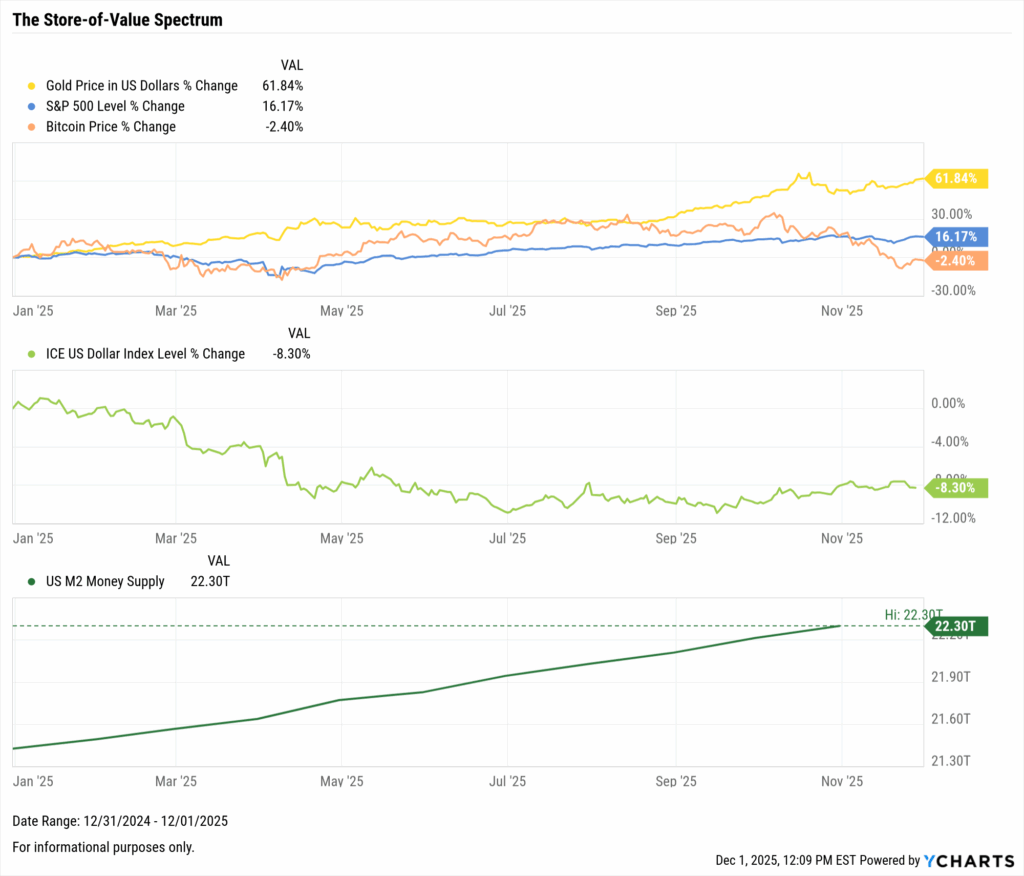
Download Visual | Modify in YCharts
Gold has been the absolute standout. Up more than 60% year to date, it has responded consistently to rising money supply, persistent fiscal concerns, and a dollar that has fallen more than 8%. This combination has helped fuel steady demand for the most traditional form of value preservation, which gold has more than reflected throughout the year.
Bitcoin has moved in the opposite direction. Even amid expanding regulation and continued institutional attention, the cryptocurrency is down more than 2% in 2025, despite having been up 35% at one point.
The weaker dollar and rising liquidity that supported gold did not have the same effect on Bitcoin, creating a notable contrast for something often positioned as a modern-day store of value.
This split does not define their long-term roles, but it shows how differently assets can move under the same conditions. One traditional hedge surged while the proposed digital alternative gave back gains, offering advisors a reference point when discussing value preservation, risk tolerance, and how various asset styles may respond to shifting economic forces.
Equity Performance: Value Shines Amidst Volatility, Healthcare Surges While Technology Pulls Back
Major Indices
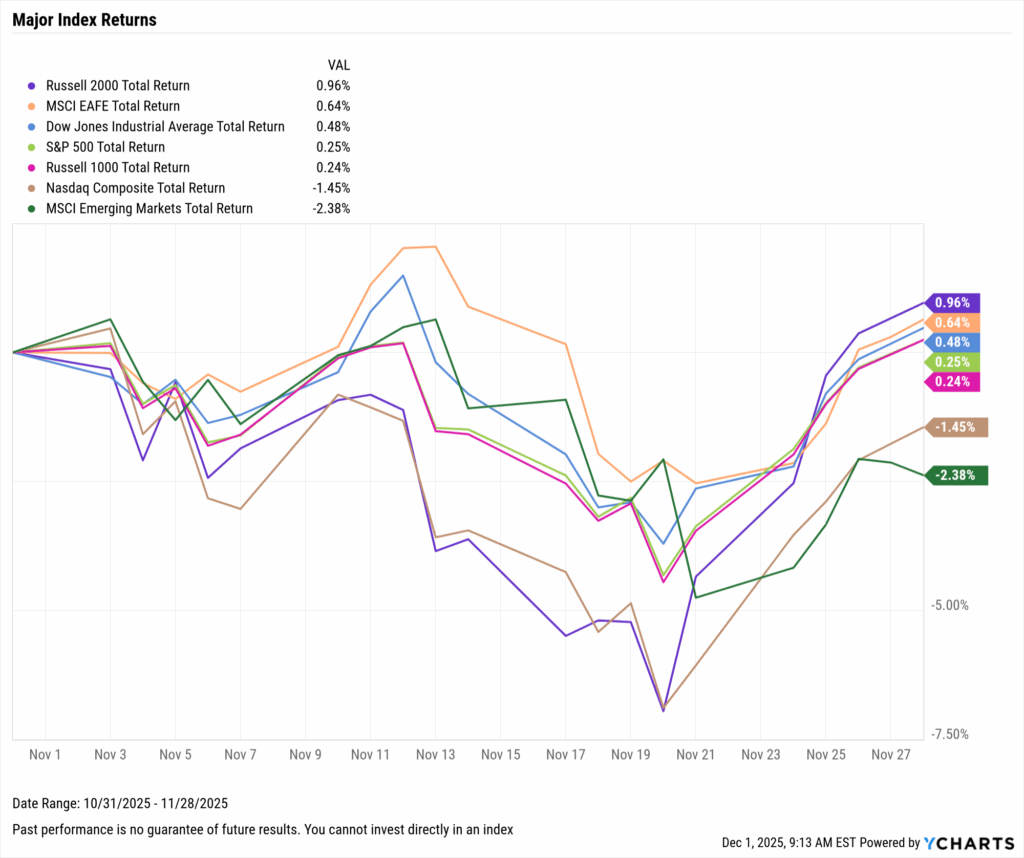
Download Visual | Modify in YCharts | View Below Table in YCharts
| Index | 1 Month Total Returns | 3 Month Total Returns | 6 Month Total Returns | 1 Year Total Returns |
|---|---|---|---|---|
| Russell 2000 | 1.0% | 6.0% | 21.8% | 4.1% |
| MSCI EAFE | 0.6% | 3.8% | 9.1% | 25.1% |
| Dow Jones Industrial Average | 0.5% | 5.1% | 13.8% | 8.0% |
| S&P 500 | 0.2% | 6.3% | 16.6% | 15.0% |
| Russell 1000 | 0.2% | 6.0% | 16.2% | 14.1% |
| Nasdaq Composite | -1.4% | 9.1% | 22.6% | 22.4% |
| MSCI Emerging Markets | -2.4% | 9.0% | 19.8% | 30.3% |
Value vs. Growth Performance
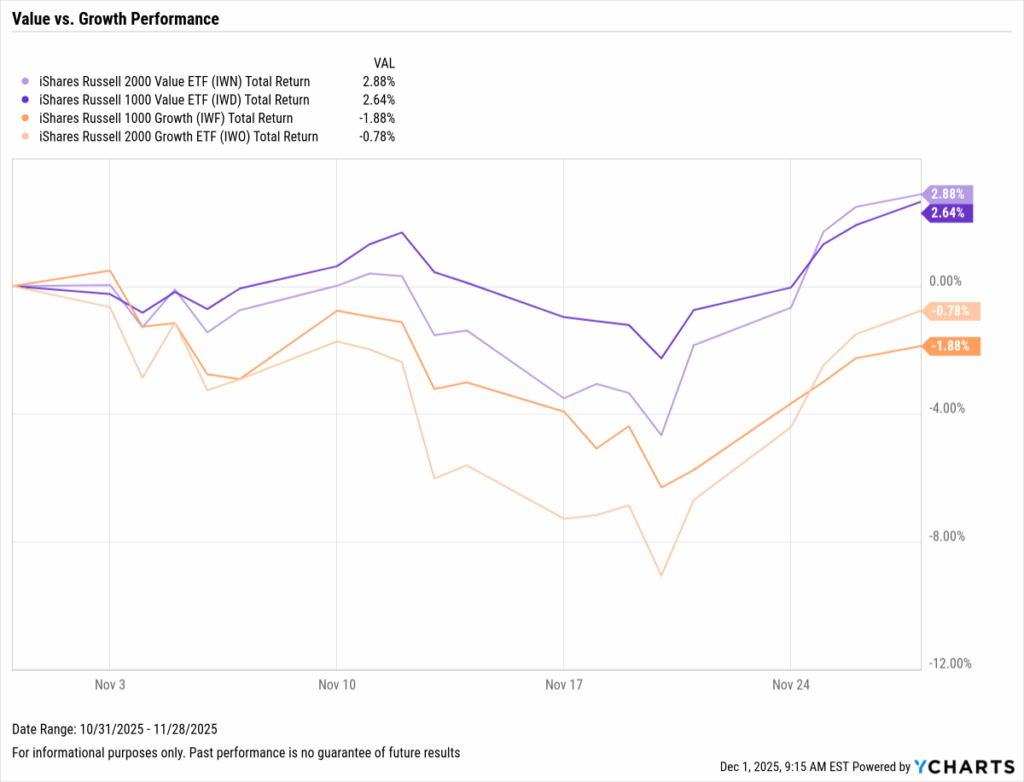
Download Visual | Modify in YCharts | View Below Table in YCharts
| Ticker | Name | 1 Month Total Returns | 3 Month Total Returns | 6 Month Total Returns | 1 Year Total Returns |
|---|---|---|---|---|---|
| IWN | iShares Russell 2000 Value ETF | 2.9% | 5.2% | 21.9% | 2.8% |
| IWD | iShares Russell 1000 Value ETF | 2.6% | 4.6% | 12.3% | 7.0% |
| IWO | iShares Russell 2000 Growth ETF | -0.8% | 6.8% | 22.0% | 4.8% |
| IWF | iShares Russell 1000 Growth | -1.9% | 7.0% | 19.5% | 20.1% |
US Sector Movement
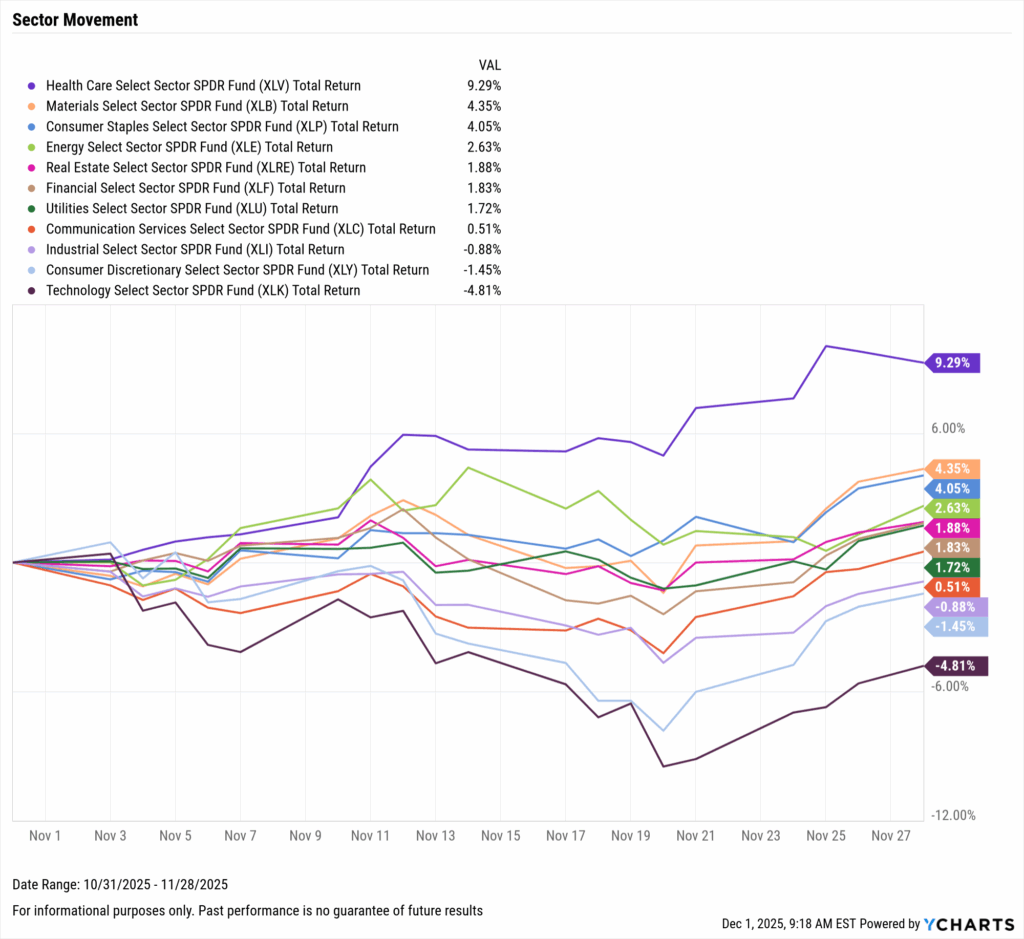
Download Visual | Modify in YCharts | View Below Table in YCharts
| Ticker | Sector | 1 Month Total Returns | 3 Month Total Returns | 6 Month Total Returns | 1 Year Total Returns |
|---|---|---|---|---|---|
| XLV | Health Care | 9.3% | 15.2% | 20.0% | 8.8% |
| XLB | Materials | 4.4% | -2.7% | 4.6% | -3.8% |
| XLP | Consumer Staples | 4.1% | -1.1% | -2.9% | -2.1% |
| XLE | Energy | 2.6% | 0.9% | 12.8% | -2.2% |
| XLRE | Real Estate | 1.9% | -0.8% | 1.5% | -4.3% |
| XLF | Financial | 1.8% | -0.9% | 5.4% | 5.4% |
| XLU | Utilities | 1.7% | 8.2% | 12.1% | 12.5% |
| XLC | Communication Services | 0.5% | 4.0% | 14.5% | 18.6% |
| XLI | Industrial | -0.9% | 1.5% | 8.4% | 8.4% |
| XLY | Consumer Discretionary | -1.4% | 2.2% | 11.0% | 7.3% |
| XLK | Technology | -4.8% | 9.2% | 24.3% | 23.2% |
Hot Stocks: Top 10 S&P 500 Performers of October 2025

Download Visual | Modify in YCharts
| Symbol | Name | 1 Month Price Returns | YTD Price Returns | Industry | Sector |
|---|---|---|---|---|---|
| ALB | Albemarle Corp. | 32.3% | 51.0% | Chemicals | Materials |
| LLY | Eli Lilly & Co. | 24.6% | 39.3% | Pharmaceuticals | Health Care |
| SOLV | Solventum Corp. | 23.5% | 29.1% | Health Care Equipment & Supplies | Health Care |
| MRK | Merck & Co., Inc. | 21.9% | 5.4% | Pharmaceuticals | Health Care |
| KVUE | Kenvue, Inc. | 20.7% | -18.7% | Personal Care Products | Consumer Staples |
| EXPD | Expeditors International of Washington, Inc. | 20.5% | 32.6% | Air Freight & Logistics | Industrials |
| REGN | Regeneron Pharmaceuticals, Inc. | 19.7% | 9.5% | Biotechnology | Health Care |
| IDXX | IDEXX Laboratories, Inc. | 19.6% | 82.1% | Health Care Equipment & Supplies | Health Care |
| AKAM | Akamai Technologies, Inc. | 19.2% | -6.4% | IT Services | Information Technology |
| BIIB | Biogen, Inc. | 18.0% | 19.1% | Biotechnology | Health Care |
Laggards & Losers: 10 Worst S&P 500 Performers of October 2025
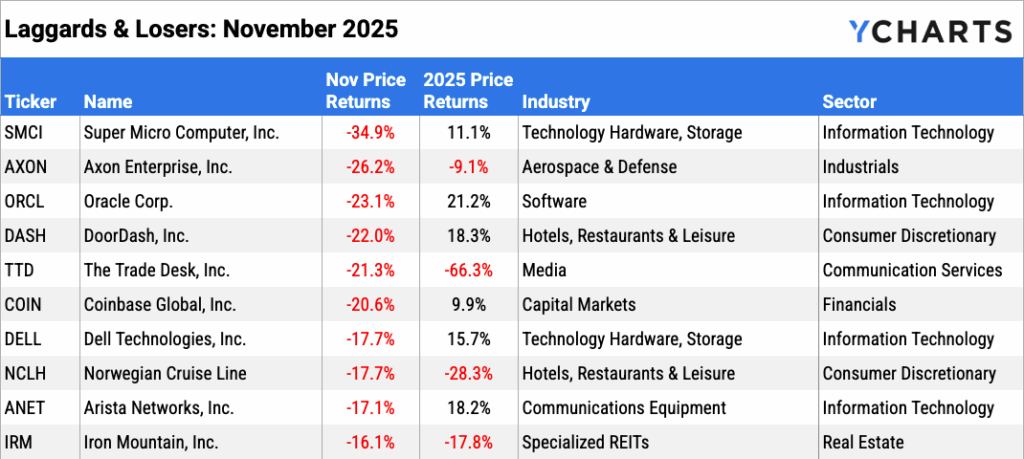
Download Visual | Modify in YCharts
| Symbol | Name | 1 Month Price Returns | YTD Price Returns | Industry | Sector |
|---|---|---|---|---|---|
| SMCI | Super Micro Computer, Inc. | -34.9% | 11.1% | Technology Hardware, Storage & Peripherals | Information Technology |
| AXON | Axon Enterprise, Inc. | -26.2% | -9.1% | Aerospace & Defense | Industrials |
| ORCL | Oracle Corp. | -23.1% | 21.2% | Software | Information Technology |
| DASH | DoorDash, Inc. | -22.0% | 18.3% | Hotels, Restaurants & Leisure | Consumer Discretionary |
| TTD | The Trade Desk, Inc. | -21.3% | -66.3% | Media | Communication Services |
| COIN | Coinbase Global, Inc. | -20.6% | 9.9% | Capital Markets | Financials |
| DELL | Dell Technologies, Inc. | -17.7% | 15.7% | Technology Hardware, Storage & Peripherals | Information Technology |
| NCLH | Norwegian Cruise Line Holdings Ltd. | -17.7% | -28.3% | Hotels, Restaurants & Leisure | Consumer Discretionary |
| ANET | Arista Networks, Inc. | -17.1% | 18.2% | Communications Equipment | Information Technology |
| IRM | Iron Mountain, Inc. | -16.1% | -17.8% | Specialized REITs | Real Estate |
Featured Market News and YCharts Insights
ETFs Won Big in 2025: Where Advisors Are Leaving Mutual Funds Behind
Why the Dot-Com Comparison Falls Short in 2025
2025 Capital Gains Watchlist: The Biggest Estimated Distributions by Peer Group
What Young Investors Don’t Know About Financial Advisors
Using Capital Gains Insights to Strengthen Advisor Partnerships
Boosting Model Adoption Across Large RIAs Through a Unified Workflow
Economic Data Overview: Softening Labor Market Key to Fed Rate Cut, Housing Market Shows Signs of Recovery
Disclaimer: Certain data in this blog is temporarily unavailable due to the federal government shutdown. For an expanded look at alternative economic indicators available during this period, visit our blog Navigating the 2025 Government Shutdown with YCharts.
Employment
September’s employment data has finally been released following the conclusion of the longest government shutdown in US history. The unemployment rate ticked up to 4.4%, and 119,000 jobs were added to the U.S. economy according to the nonfarm payrolls report. This came in well above the Dow Jones estimate of 50,000, a surprising beat for the first time in five months.
The Labor Department has confirmed the cancellation of October’s reports, although advisors can continue to track labor conditions in YCharts using alternative datasets. ADP Employment Change and ADP Private Employment provide monthly updates on private-sector payroll growth, while the Challenger Report highlights announced layoffs and sector-level shifts.
Consumers and Inflation
The Bureau of Labor Statistics has canceled the release of October’s inflation data, a big decision just before the Federal Reserve’s December rate meeting. In September, the US inflation rate rose to 3.01% and the US Consumer Price Index sits at 0.3% MoM.
The FedWatch tool now indicates an over 85% chance for a third consecutive cut when the FOMC meets next on December 10th. Despite lacking the full scope of key economic indicators, investors are increasingly pricing in another 25 basis point cut to close out 2025.
Production and Sales
The US ISM Manufacturing PMI decreased to 48.2 in November, its second consecutive monthly decrease. The Services PMI increased 2.4 points to 52.4 in October. The YoY US Producer Price Index and US Retail and Food Services Sales have both remained unreleased since September due to the federal shutdown.
Housing
Existing Home Sales increased by 1.2% MoM in October, and the Median Sales Price of Existing Homes remains at $415,200. Mortgage rates increased slightly throughout November, with the 15-year Mortgage Rate at 5.51% and the 30-year at 6.23% to end the month.
While US New Single-Family Home Sales remain unreported, the NAHB Housing Market Index can be used to measure homebuilder confidence, providing an early indication of construction sentiment and future building activity.
Commodities
The price of gold increased this month by 6.2% following what was a volatile October. SPDR Gold Shares ETF (GLD) sits at $387.88 per share. Oil prices decreased, with Brent crude down 0.9% for the month to $64.83 per barrel. WTI was hit a bit harder, down by 4.3% to $59.11.
Cryptocurrencies
Major cryptocurrencies posted a very rough November, with both major players down nearly 20%. Bitcoin fell 17.5% (~$19,000 per coin) to below $100,000 for the first time since May. This month wiped out all of 2025’s gains, shockingly leaving the asset down over 2% YTD.
Ethereum struggled even more, down 22.2% in November, following a 9.8% decline in October. This move leaves ETH down 11% in 2025, despite a record-breaking summer period.
Fixed Income Performance: Insights into Bond ETFs and Treasury Yields
US Treasury Yield Curve
1 Month Treasury Rate: 4.05%
3 Month Treasury Rate: 3.88%
6 Month Treasury Rate: 3.74%
1 Year Treasury Rate: 3.61%
2 Year Treasury Rate: 3.47%
3 Year Treasury Rate: 3.49%
5 Year Treasury Rate: 3.59%
10 Year Treasury Rate: 4.02%
20 Year Treasury Rate: 4.62%
30 Year Treasury Rate: 4.67%
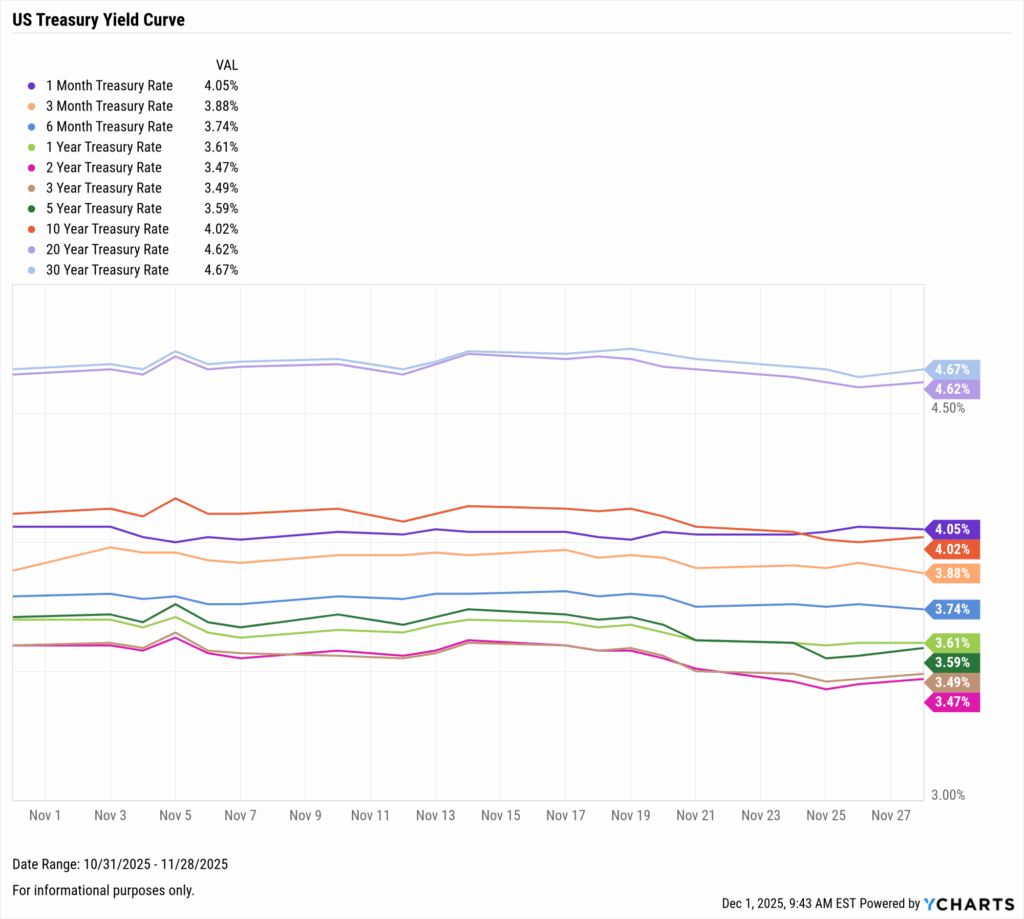
Download Visual | Modify in YCharts
Bond Fund Performance
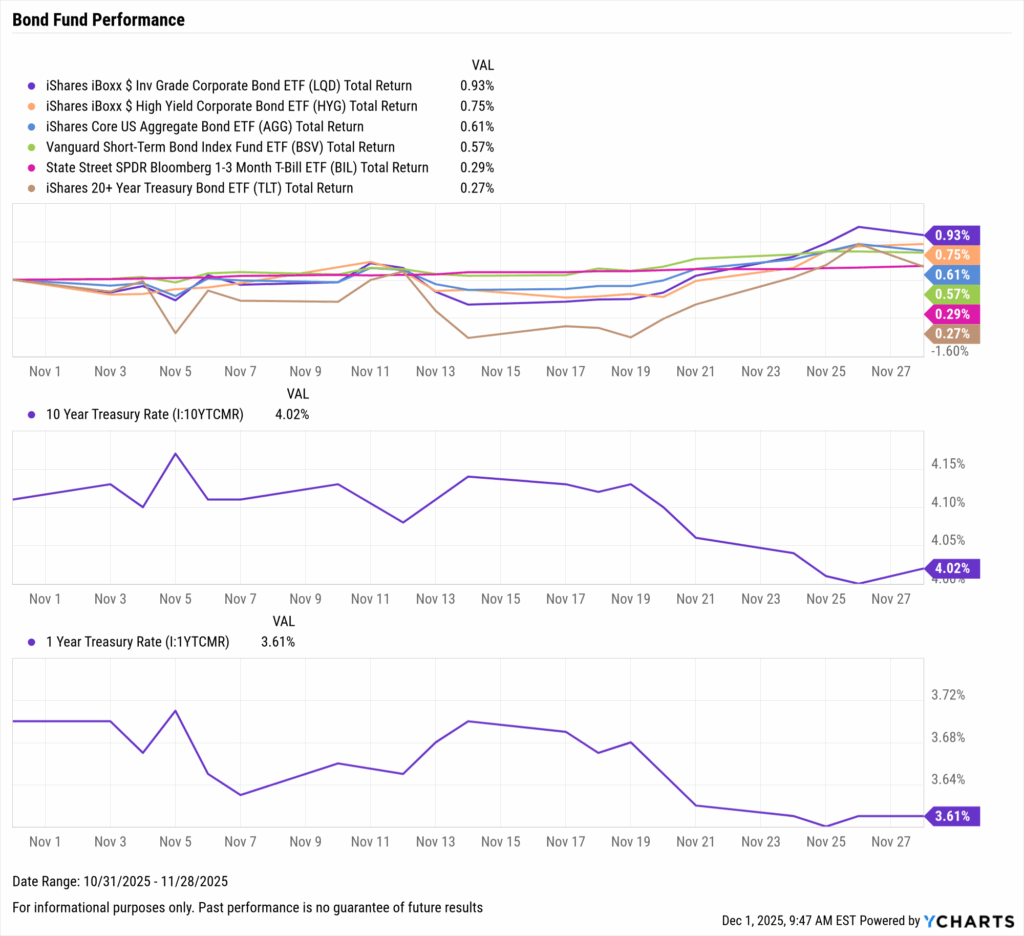
Download Visual | Modify in YCharts | View Below Table in YCharts
| Ticker | Name | 1 Month Total Returns | 3 Month Total Returns | 6 Month Total Returns | 1 Year Total Returns |
|---|---|---|---|---|---|
| LQD | iShares iBoxx $ Inv Grade Corporate Bond ETF | 0.9% | 3.0% | 6.1% | 5.8% |
| HYG | iShares iBoxx $ High Yield Corporate Bond ETF | 0.7% | 1.6% | 4.8% | 7.2% |
| AGG | iShares Core US Aggregate Bond ETF | 0.6% | 2.4% | 4.8% | 5.7% |
| BSV | Vanguard Short-Term Bond Index Fund ETF | 0.6% | 1.2% | 3.0% | 5.7% |
| BIL | State Street SPDR Bloomberg 1-3 Month T-Bill ETF | 0.3% | 1.0% | 2.0% | 4.2% |
| TLT | iShares 20+ Year Treasury Bond ETF | 0.3% | 5.3% | 6.9% | 0.3% |
As we close out 2025, monitor the effects of continued rate cuts and alternative economic data in the wake of the government shutdown. Download the visual aids directly from YCharts, and contact us for customized access to these charts.
Have a great December! 📈
Whenever you’re ready, there are three ways YCharts can help you:
1. Looking for a tool to help you better communicate market events?
Email us at hello@ycharts.com or call (866) 965-7552. You’ll be directly in touch with one of our Chicago-based team members.
2. Want to test out YCharts for free?
Start a no-risk 7-Day Free Trial.
3. Download a copy of the Monthly Market Wrap slide deck:
Disclaimer
©2025 YCharts, Inc. All Rights Reserved. YCharts, Inc. (“YCharts”) is not registered with the U.S. Securities and Exchange Commission (or with the securities regulatory authority or body of any state or any other jurisdiction) as an investment adviser, broker-dealer or in any other capacity, and does not purport to provide investment advice or make investment recommendations. This report has been generated through application of the analytical tools and data provided through ycharts.com and is intended solely to assist you or your investment or other adviser(s) in conducting investment research. You should not construe this report as an offer to buy or sell, as a solicitation of an offer to buy or sell, or as a recommendation to buy, sell, hold or trade, any security or other financial instrument. For further information regarding your use of this report, please go to: ycharts.com/about/disclosure
Next Article
An Advisor’s Guide to Track, Analyze, and Act on Capital GainsRead More →
